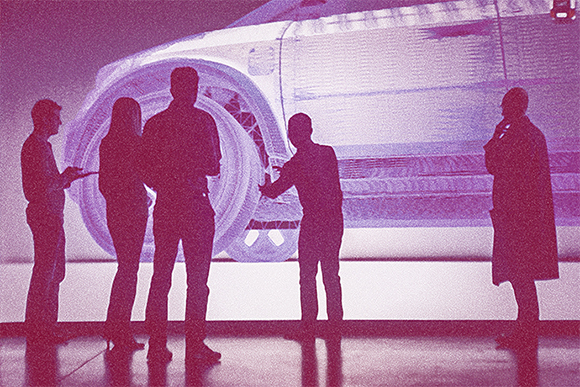|
  
| FROM SITE SELECTION MAGAZINE, JULY 2021 ISSUE |

|
OKLAHOMA
“We ran a multi-state competition, and Oklahoma was head and shoulders above the other contenders,” said Canoo Chairman and CEO Tony Aquila in June. Read our report to find out why.
|
|
| CONWAY ANALYTICS SNAPSHOT |
 |
Archive photo courtesy of Hessen Trade and Invest
|
|
Among the global research activities of St. Louis-based early-stage tech venture capital firm SixThirty is the mapping of Europe’s fintech scene (including insurtech, cybersecurity and digital health). The SixThirty team late in 2020 whittled a list of some 700 fintech firms headquartered in Europe to a list of around 70 that were selling into financial institutions. Among their findings:
- Of the ca. 70 firms (Enterprise FinTech firms that have raised a Series A round or later), over one-third of the companies have a U.S. presence.
- The majority entered the U.S. market between Year 3–6 since founding.
- Nearly half of the firms are based in the UK, with Germany, France, Switzerland, Sweden and The Netherlands among other key hubs.
- Nearly one-third of the firms have scaled to over 100 staff.
The complete 114-page project, “Scaling Enterprise FinTech: The Handbook,” was published in March, noting that those HQ locations tend to be in specific metros, with London home to more than half of 65 examined companies, and other hubs developing in Berlin, Paris, Amsterdam, Zurich, Cambridge and Munich. When the firms locate to the U.S., they tend to go to New York, with a few landing in Boston or San Francisco.
How does the location data of European fintechs match up with that of financial services in Europe overall? Conway Analytics data on financial services projects across several industry codes covering banking and financial/insurance services reveals 68 major facility projects from corporations over the past decade, with London indeed leading the way at seven projects. However, lurking just one project behind are Dublin, Frankfurt and — if Eastern Europe is allowed to play — Warsaw, Poland. Locations with at least three projects apiece include Paris; Cardiff, Wales; and Belfast in Northern Ireland. — Adam Bruns |
|
  |
| 2021 MISSISSIPPI DEVELOPMENT GUIDE |
 |
STATISTICAL PROFILE
A selection of data paints a picture of the state in terms of projects, geography, trade, workforce and more.
|
|
Costa Rica
Quebec-based Baylis Medical, a company that develops cardiological medical devices, announced in late July it is establishing a manufacturing plant in La Lima Free Zone, in Cartago, where it will manufacture cardiovascular products to serve global markets. “Our team in Costa Rica will be instrumental in helping us serve patients through leading cardiology devices that will improve the lives of people around the world for years to come,” said Kris Shah, president of Baylis Medical. The company cited Costa Rica’s well-established medical device manufacturing sector and its highly skilled workforce for its investment decision. “Thanks to its acknowledged track record in life sciences, the country has 12 of the world’s 30 leading medical firms,” said Jorge Sequeira, CINDE’s managing director. “Today, Baylis Medical joins the cluster, which by the end of 2020 consisted of 81 companies and generated an accumulated total of more than 38,000 jobs in Costa Rica.”
Michigan
Also in late July, the Michigan Economic Development Corporation announced that EOTech, a manufacturer of optics for small weapon sights, is establishing new operations in Traverse City with support from the Michigan Strategic Fund. The company will create 165 new jobs there, and will also retain 145 jobs at its headquarters facility in Plymouth, where it is also expanding. Michigan was chosen over a competing site in Ohio. EOTech was established in 1995 as part of military and environmental research being conducted by the Environmental Research Institute of Michigan. The company focuses heavily on hiring veterans and people with disabilities, while aligning with key focus industries in MEDC’s strategic plan, including advanced manufacturing and engineering, design, and development. “EOTECH is proud to partner with MEDC to expand our operations, create new jobs in Michigan and provide excellent service to our consumer, law enforcement and military customers,” said EOTech CEO Matt Van Haaren.
|
|

|
INDUSTRIAL DEVELOPMENT-READY SITES IN MARSHALL CO., MISSISSIPPI
Strategically located in North Mississippi, Springs Industrial Park boasts 3,000 acres of prime industrial property in Holly Springs. The shovel-ready site offers superior connectivity to domestic and foreign markets with its ease-of-access to major highways and interstates, airports, railways and waterways. Additionally, Springs Industrial Park is the only BNSF-Certified industrial park in the Southeast U.S., with 1,200 acres offering the convenience of direct access to the BNSF Mainline. Served by the Tennessee Valley Authority, the site currently has more than 60 megawatts of power.
The Marshall County location also ensures a business-friendly atmosphere, fast-tracked construction to guarantee start-up goals are met and discretionary incentives for qualifying industries. An existing workforce of more than 700,000 is available within a 60-minute commute to Marshall County, and workforce training through nearby universities and colleges is available to meet businesses’ unique training needs.
To learn more, contact Justin Hall at the Marshall County Industrial Development Authority at (662) 252-3916. |
|
| SITE SELECTION RECOMMENDS |
 | Rivian’s looking to create a new site as well as new vehicles.
Archive photo courtesy of Rivian Automotive
|
|
 |
It may look like a super-imposed artist’s photo-rendering, but it’s not. That’s the color you get from evaporation ponds at lithium mining sites like this one operated by SQM in the Salar de Atacama in Chile. The photo was shared by Argonne National Laboratory in July as it released a new study evaluating more sustainable methods of producing lithium, a key ingredient in today’s electric vehicle batteries. The International Energy Agency predicts that demand for lithium may grow by as much as 40 times between 2020 and 2040, mainly due to global deployment of EVs.
“Examination of current lithium production and the pursuit of future production, including from within the U.S., are critical to sustaining electric vehicle deployment,” said Michael Wang, director of the Systems Assessment Center at Argonne and a study co-author. Later in July, Argonne released another study sure to pique the interest of economic developers and corporate end users alike: a 10-year breakdown of the battery supply chain in America, including battery cell and battery pack capacity by country. The word “location” occurs 218 times in the 105-page report. — Adam Bruns
|
|
|
|

